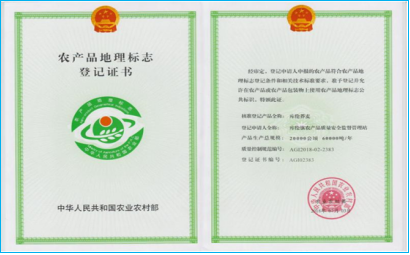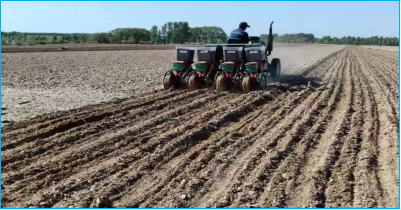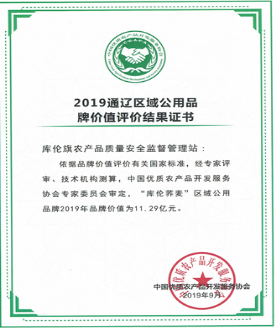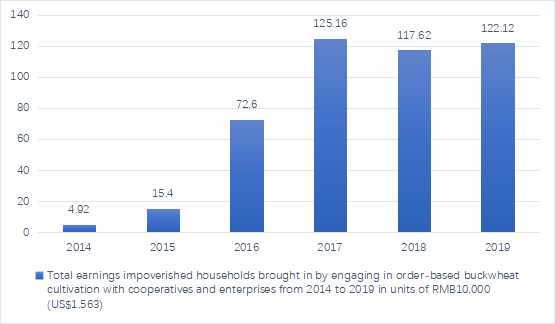Measures
Situated in the southwest area of Inner Mongolia Autonomous Region, the Hure Banner spans a total of 4,716 square kilometres. More than 1,003 of these square kilometres are made up of arable land, 1,460 of forestland and 2,000 of prairieland.
In 2014, 26,625 of Hure's inhabitants were living below the poverty line. This meant that 19.07 percent of the banner's total population were living in impoverished conditions. The banner's relatively poor natural and geographic conditions meant that the development of local industries was lagging behind the national average, causing residents to continue enduring poverty and hardship. Across the banner, soil that covers low mountain areas and valleys is relatively infertile, which means that, on average, the Hure Banner suffers from drought nine out of every ten years. Short-duration crops that are resistant to drought and barren land, therefore, play a significant role in Hure's agricultural production.
The local Hure government formulated and implemented a buckwheat vitalisation plan a few years ago, outlining various supportive measures, including programmes that encourage farmers, herders, large farming families and cooperatives to engage in large-scale cultivation. Since the implementation of the plan, total land area devoted to perennial cultivation of Hure-farmed buckwheat has stabilised at around 13,333 hectares, resulting in approximately 30,000 tons of annual yields.

An agricultural product geographical indication certificate issued to Hure by the Ministry of Agriculture and Rural Affairs in 2018
The Inner Mongolia Academy of Agricultural and Animal Husbandry Sciences, along with the Tongliao Institute of Agriculture and Animal Husbandry, have helped Hure achieve major improvements related to quality and yields. These improvements have been achieved through expert selection and promotion of excellent buckwheat varieties. The two institutes have also helped Hure focus on breeding highly adaptable, high-yield varieties of common and Tartary, or bitter buckwheat. Such strategic changes have helped the Hure locality address major problems associated with its previously used mixed varieties, such as low yields and substandard qualities.
Besides fostering strong partnerships, the Hure government has introduced, demonstrated and experimented with sowing, harvesting, and threshing tools and machines. It has also been helping impoverished households and other farmers purchase agricultural machinery, which has resulted in reduced labour input, simplified cultivation procedures, increased efficiency, engagement with intensive and large-scale production, reduced costs, and resulted in higher local incomes.

A farmer tills a field in Hure. Mechanised agriculture has greatly increased buckwheat production among the banner's farming families and cooperatives.
Indeed, the application of new technology and provision of practical training has been strengthened significantly in the local area. A new training programme designed to benefit and prioritise Hure's impoverished farmers and herders has resulted in the emergence of large family farms, farmers' cooperatives and other major buckwheat producers. During one-on-one, on-site programme training, agricultural technicians provide technical guidance related to efficiency, agrometeorological disaster mitigation, disease and pest prevention and control, as well as other key expertise.
Hure's local traditional buckwheat industry was historically and typically characterised by fragmented, non-standardised farming, basic processing of raw buckwheat, and localised consumption. However, the rise of large-scale intensive processing enterprises and corresponding brand and product development have played an important role in the transformation of the industry. The local government's processing interventions have moulded a modern industry that has achieved large-scale cultivation, deep and intensive processing, and sales in both domestic and foreign markets. This transformation has resulted in a new industrial layout that is driven by impoverished households, farmers, buckwheat demonstration bases and enterprises, and that integrates processing, marketing, crop cultivation, and animal husbandry projects, including beekeeping in buckwheat fields and utilisation of buckwheat by-products as feed for black pig farming.
As noted, strengthened brand development efforts have played a key role in transforming the buckwheat industry. By applying best practices deriving from Hure's existing buckwheat brands, the banner has succeeded in issuing branding guidance and delivering brand-related training to local farmers. This guidance and training encompass the certification process of local buckwheat products with green, organic and geographical indication labelling. Trained professionals provide on-site guidance to cooperatives, enterprises and farming families, helping them with operations such as management of pesticide application. This guidance is issued in line with locally established agricultural regulations and standards.

A certificate indicating the result of Hure's regional buckwheat brand value evaluation that was conducted in 2019
Key outcomes
Local buckwheat farming, especially order-based cultivation, has yielded favourable and sustainable changes for Hure residents. In 2019, buckwheat cultivation enabled 17,583 residents living in 6,077 impoverished households to increase their incomes by a combined total of RMB2.43 million (US$379,688), or an average of RMB400 (US$63) per household. Buckwheat cultivation has also enabled 2,950 impoverished farmer and herder households working for food, tourism and culture businesses within the buckwheat industry to increase their incomes by a combined total of RMB59 million (US$9.22 million), or an average of RMB20,000 (US$3,125) per household.

By fostering the development of intensive processing enterprises, the banner has improved the value of the "Hure Buckwheat" brand and extended its value chain. This has resulted in obvious market advantages and boosted buckwheat cultivation in other counties and cities in the area.
Lessons learned
The Hure locality has demonstrated that proper funding, technology advancement, marketing and branding development, consumption innovation and other sustainability-focused actions can help to reduce poverty rates, increase incomes for farmers and herders, and promote rural vitalisation in pastoral areas. By moving from upstream cultivation to downstream consumption, Hure has also demonstrated that agricultural industries like the buckwheat industry can enhance efficiency within their supply chains.
The success stories coming out of Hure's buckwheat industry revolution show that a characteristic, high-value industrial chain can be cultivated by way of effectively integrating local ethnic culture, ecotourism resources and dining traditions. Ultimately, building a sustainable industrial chain has proven to be a vital method for tackling poverty rates and enhancing quality of life for locals.
References: http://south.iprcc.org/#/casestudies/caseDetails?id=631
For more information, please contact WFP China COE (wfpcn.coe@wfp.org)
Category
Buckwheat Development Plan Improves Local Industrial Chain
Contributor
Buckwheat Development Plan Improves Local Industrial Chain
Country
Case Study

